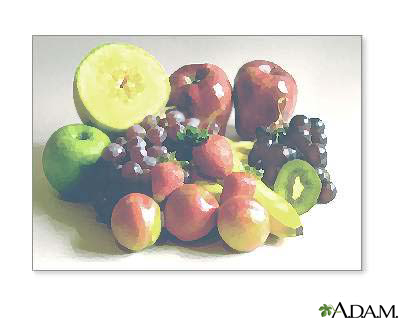Pesticides on fruits and vegetables
 Print-Friendly
Print-Friendly
Fruits and vegetables - pesticide risks
To help protect yourself and your family from pesticides on fruits and vegetables:
- Wash your hands with soap and water before you start preparing food.
- Discard the outer leaves of leafy vegetables such as lettuce. Rinse and eat the inner part.
- Rinse produce with cool water for at least 30 seconds.
- You can buy a produce wash product. Do not wash foods with dish soaps or detergents. These products can leave behind inedible residues.
- You do not need to wash produce marked "ready to eat" or "pre-washed".
- Wash produce even if you do not eat the peels (such as citrus). Otherwise, chemicals or bacteria from the outside of the produce can get to the inside when you cut/peel it.
- After washing, pat produce dry with a clean towel.
- Wash produce when you are ready to use it. Washing before storing can degrade the quality of most fruits and vegetables.
- As an option, you may want to buy and serve organic produce. Organic growers use approved organic pesticides. You may want to consider it for thin-skinned items such as peaches, grapes, strawberries, and nectarines.
To remove harmful bacteria, you must wash both organic and nonorganic fruits and vegetables.
I Would Like to Learn About:
Information
To help protect yourself and your family from pesticides on fruits and vegetables:
- Wash your hands with soap and water before you start preparing food.
- Discard the outer leaves of leafy vegetables such as lettuce. Rinse and eat the inner part.
- Rinse produce with cool water for at least 30 seconds.
- You can buy a produce wash product. Do not wash foods with dish soaps or detergents. These products can leave behind inedible residues.
- You do not need to wash produce marked "ready to eat" or "pre-washed".
- Wash produce even if you do not eat the peels (such as citrus). Otherwise, chemicals or bacteria from the outside of the produce can get to the inside when you cut/peel it.
- After washing, pat produce dry with a clean towel.
- Wash produce when you are ready to use it. Washing before storing can degrade the quality of most fruits and vegetables.
- As an option, you may want to buy and serve organic produce. Organic growers use approved organic pesticides. You may want to consider it for thin-skinned items such as peaches, grapes, strawberries, and nectarines.
To remove harmful bacteria, you must wash both organic and nonorganic fruits and vegetables.
Related Information
References
Forman JA, Zajac LM. Chemical pollutants. In: Kliegman RM, St. Geme JW, Blum NJ, et al, eds. Nelson Textbook of Pediatrics. 22nd ed. Philadelphia, PA: Elsevier; 2025:chap 759.
US Food & Drug Administration. Food facts: raw produce: selecting and serving it safely www.fda.gov/downloads/Food/FoodborneIllnessContaminants/UCM174142.pdf. Updated July 2023. Accessed May 7, 2024.



